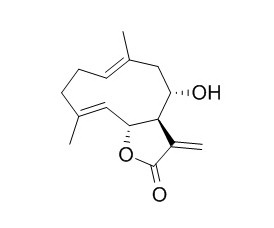Neobritannilactone B
Neobritannilactone B has cytotoxic activity.
Inquire / Order:
manager@chemfaces.com
Technical Inquiries:
service@chemfaces.com
Tel:
+86-27-84237783
Fax:
+86-27-84254680
Address:
1 Building, No. 83, CheCheng Rd., Wuhan Economic and Technological Development Zone, Wuhan, Hubei 430056, PRC
Providing storage is as stated on the product vial and the vial is kept tightly sealed, the product can be stored for up to
24 months(2-8C).
Wherever possible, you should prepare and use solutions on the same day. However, if you need to make up stock solutions in advance, we recommend that you store the solution as aliquots in tightly sealed vials at -20C. Generally, these will be useable for up to two weeks. Before use, and prior to opening the vial we recommend that you allow your product to equilibrate to room temperature for at least 1 hour.
Need more advice on solubility, usage and handling? Please email to: service@chemfaces.com
The packaging of the product may have turned upside down during transportation, resulting in the natural compounds adhering to the neck or cap of the vial. take the vial out of its packaging and gently shake to let the compounds fall to the bottom of the vial. for liquid products, centrifuge at 200-500 RPM to gather the liquid at the bottom of the vial. try to avoid loss or contamination during handling.
Viruses.2017, 9(10)
Phytomedicine2022, 104:154337.
Journal of Ginseng Research2019, 10.1016
Enzyme Microb Technol.2019, 122:64-73
Cell J.2024, 26(8):496-504.
J of Advanced Scientific R.2020, 11(3), p109-120.
Journal of Functional Foods2022, 96: 105216.
Virus Res.2023, 335:199199.
Front Plant Sci.2021, 12: 648426.
J Ethnopharmacol.2019, 244:112074
Related and Featured Products
Arch Pharm Res. 2014 May;37(5):567-74.
Hypo-pigmenting effect of sesquiterpenes from Inula britannica in B16 melanoma cells.[Pubmed:
24346861]
During the course of screens to identify anti-melanogenic agents from natural resources, we found that the methanol extract of the dried flower of Inula britannica L. inhibited melanin synthesis in cultured melanoma cells stimulated with 3-isobutyl-1-methylxanthine (IBMX).
METHODS AND RESULTS:
A bioassay-guided isolation of the chloroform fraction of the I. britannica using an in vitro melanogenesis inhibition assay led to the isolation of sesquiterpenes, 1-O-acetylbritannilactone (1), britannilactone (2) and Neobritannilactone B (3). Compounds 1 and 2 significantly reduced melanin production in a dose-dependent manner with IC50 values of 13.3 and 15.5 μM, respectively, whereas compound 3 was found to be cytotoxic. Compound 1 also inhibited the tyrosinase activity only in cell based-systems. Western blot analysis indicated that compound 1 inhibited melanogenesis by activating extracellular signal-regulated kinase (ERK) and Akt signaling and also inhibiting cAMP related binding protein, which regulates its downstream pathway, including tyrosinase, tyrosinase related protein-1 and TRP-2.
CONCLUSIONS:
These results demonstrated that compound 1, a major sesquiterpene from the flowers of I. britannica, exhibited anti-melanogenic activity by suppression of tyrosinase expression via ERK and Akt signaling. Taken together, our results suggest that these compounds may act as potent natural skin-lightening agents.



